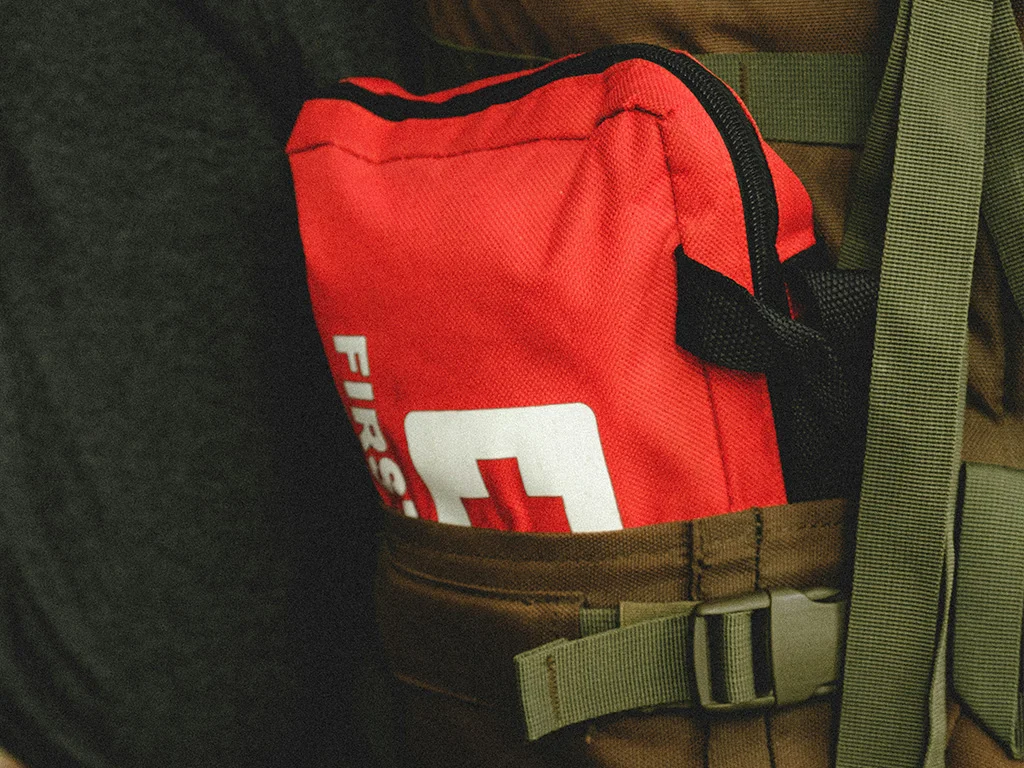Heading into the bush or campsite? Start with a good pre-packaged first aid kit as your base – it provides the essentials so you’re not scrambling from scratch. From there, customize the kit to your trip’s specifics: where you’re camping, how many people are in your group (kids or adults), and what activities you have planned.
Your kit should be as unique as your camping trip, factoring in trip length, group size and location. For example, if you have known allergies (nuts, insect bites or stings, etc.), add an EpiPen or extra antihistamines. If you’re with children, double up on kid-friendly pain relievers and bandages.

Also, If you’re camping in the Lockyer Valley or other remote areas, remember that the wild can be unpredictable, so it’s best to be prepared. Remember that nature has its own agenda, so make sure your kit is tailored to whatever it can throw at you out of the blue.
A convenient way to start is a lightweight, pre-packed first aid kit. Many kits list their size and weight (for instance, a 115-piece family kit measures about 9″×3″×12.5″ and weighs ~2.05 lbs), so you can choose one that won’t weigh down your pack.
Then add extras based on where you’re going: extra insect repellent and tick tweezers for bush camping, burn gel and high-SPF sunscreen for sunny days, oral rehydration or glucose tablets for long hikes in heat, and child-specific items like junior fever medication and fun bandages. This way, your camping aid kit is both portable and well-stocked for the conditions of your trip.
Camping First Aid Kit Checklist
Make sure your kit covers the basics. Experts recommend packing bandages, gauze, antiseptics, and common medications before you leave. The table below shows key items, suggested quantities, and their uses. Quantities depend on group size and trip length (for a family, pack extra; for a solo camper, one kit’s worth may suffice).
| Category | Item | Qty | Purpose |
| Essential Supplies | Adhesive bandages (assorted sizes) | At least 20 each size | Cover small cuts, blisters, minor wounds |
| Sterile gauze pads | 5–10 | Cover larger wounds or pad bleeding | |
| Medical tape | 1 roll | Secure bandages and gauze | |
| Antiseptic wipes or solution | 10+ wipes / small bottle | Clean wounds to prevent infection | |
| Antibacterial ointment | 2–3 tubes | Prevent infection in cuts/scrapes | |
| Hydrocortisone cream 1% (small tube) | 1 | Relieve itching/swelling from bites/rashes | |
| Burn gel or aloe gel | 1 tube | Treat sunburns or minor burns | |
| Instant cold pack | 1–2 packs | Reduce swelling on sprains/strains | |
| Hand sanitizer (alcohol gel) | 1 | Hand hygiene to prevent infection | |
| Disposable gloves | 4–6 pairs | Protect you and patient from infection | |
| Medications & Treatments | Pain relievers (adult) – paracetamol (Panadol) or ibuprofen | Pack enough for trip | Alleviate pain, fever |
| Pain relievers (children) – child-dose paracetamol/ibuprofen | 1–2 packets or bottles | Child pain/fever relief | |
| Antihistamines (adult) – e.g., cetirizine (Zyrtec) | 10–20 tablets | Treat allergic reactions | |
| Antihistamines (children) | Liquid/chewable, 1 small bottle | Child allergy relief | |
| Anti-diarrheal medication (e.g., loperamide) | 2–4 tablets | Manage stomach upsets/diarrhea | |
| Eye drops (sterile saline/lubricating) | 1 bottle | Rinse or soothe irritated eyes | |
| Insect repellent (DEET or picaridin) | 1–2 bottles | Prevent mosquito/tick bites | |
| Aloe or after-sun gel | 1 bottle | Soothe sunburned skin | |
| Personal prescription meds (EpiPen, inhaler, etc.) | As needed | Manage chronic conditions or severe allergies | |
| Oral glucose tablets | 1 small box | Quickly raise blood sugar (hypoglycemia) | |
| Emergency Gear | LED flashlight or headlamp | 1 (plus spare batteries) | Illuminate campsite; signal for help |
| Hand-crank weather radio with LED | 1 | Get weather alerts/off-grid info | |
| Emergency blanket (thermal reflective) | 1–2 | Retain body heat in shock or cold | |
| CPR face shields/masks | 2–4 | Barrier protection if performing CPR | |
| First aid manual or pocket guide | 1 | Quick reference for wilderness/remote first aid | |
| Children’s Items | Children’s adhesive bandages (fun prints) | 10–20 | Make small injuries less scary for kids |
| Children’s pain reliever (liquid/paracetamol) | 1 bottle | Child pain/fever relief | |
| Children’s antihistamine (liquid/chewable) | 1 small bottle | Child allergy relief | |
| Tools | Tweezers (fine-point) | 1 | Remove splinters or ticks |
| Scissors (blunt-tip) | 1 | Cut gauze, tape or clothing as needed | |
| Thermometer (digital) | 1 | Check for fever | |
| Elastic wrap bandage (e.g., ACE bandage) | 2 rolls | Support sprains/strains | |
| Splint (or rigid support) | 1 | Immobilize fractures or serious sprains | |
| Tourniquet | 1 | Control severe bleeding | |
| Optional Extras | Duct tape (small roll) | 1 | Versatile fixes – gear, or makeshift bandages |
| Smartphone power bank/charger | 1 | Keep your phone charged for maps/SOS | |
| Whistle | 1 | Signal rescuers if needed | |
| Waterproof notebook & pen | 1 each | Record details or notes | |
| Sunscreen (SPF 30+) | 1 tube | Prevent sunburn (use even on cloudy days) |
Each of these items plays a role in camping safety. For example, bandages and gauze handle cuts and scrapes; antiseptic wipes and antibacterial ointment fight infection; and disposable gloves protect both rescuer and patient. Medications include pain relievers and antihistamines for adults and children, as well as eye drops, antihistamines, anti-diarrhea tablets and personal medications to cover allergies or stomach upsets. Emergency gear like a hand-crank radio, LED flashlight and emergency blanket ensure you’re prepared for cold nights.
Why You Need a First Aid Kit for Camping
Even a simple camping trip can bring surprises: slippery rocks, thorns, or sudden weather changes. A properly stocked first aid kit is your safety net. A first aid kit isn’t just a box of supplies, but an essential part of your camping gear that provides peace of mind. It’s there to address minor injuries like cuts, bruises or sprains before they become serious, and to keep you comfortable. Having first aid supplies on hand can prevent small problems from escalating into emergencies. Knowing you have bandages, pain relievers, and the right medications helps everyone relax and enjoy the outdoors safely.
Common Camping Injuries
While camping you should watch out for several typical injuries or ailments. A well-prepared kit helps handle each of these quickly:
- Insect & Tick Bites: Prevent bites with a long-sleeve shirt and insect repellent. If bitten, clean the area, apply antiseptic and hydrocortisone cream to reduce itching. Antihistamines can ease allergic reactions. Always carry fine-point tweezers to carefully remove ticks, if there are any.
- Burns: Campfires and cooking stoves can cause burns or scalds. At the first sign of a burn, cool it with clean water. Use burn gel or aloe gel from your kit to soothe the skin. Cover the burn loosely with a sterile dressing. (Aloe gel also helps with sunburn if you forget the sunscreen.)
- Sprains & Strains: Twisting an ankle or overextending a knee is easy on uneven terrain. An elastic wrap or triangular bandage can support the joint immediately, and a cold pack reduces swelling. Keep the injury elevated if possible and use pain relievers as needed. For serious sprains or fractures, apply a splint (or improvise with a firm stick) and seek help.
- Sunburn: Apply broad-spectrum SPF 30+ sunscreen generously, especially in the summer months, before you head out. If you do get sunburnt, apply aloe gel from the kit and drink plenty of fluids.
- Dehydration & Heat Exhaustion: Hot days call for extra water and salt. Drink regularly and rest in the shade. Signs of dehydration or heat exhaustion (dizziness, rapid pulse) mean cool down and replenish electrolytes. Having oral glucose tablets or rehydration salts in your kit can help stabilize blood sugar or salt levels.
- Minor Fractures & Bruises: Falls can lead to cracked bones or bad bruises. If you suspect a minor fracture, immobilize the limb (splint or wrap) and keep it still until help arrives. For bruises and bumps, cold packs and pain relief cut swelling and soreness.
By knowing these common risks — ranging from insect bites and ticks to dehydration, heat exhaustion, burns, strains and fractures — you can use your kit to treat small problems on the spot. Staying proactive and having first aid supplies means a minor mishap won’t ruin your trip.
Camping at Murphy’s Creek Escape
Murphy’s Creek Escape is a family-friendly bushland campsite in the beautiful Upper Lockyer Valley. Here you can truly unwind under the stars, let the kids play in nature, and enjoy facilities like covered camp kitchens and a billabong to swim in. While our setting is relaxed, we always encourage guests to plan ahead for safety.
Bringing a stocked first aid kit (whether at our spacious family camping area or our tranquil bush camping areas) ensures that any little incident is quickly handled.
Whether you’re camping with kids or seeking peaceful adult bush camping, Murphy’s Creek Escape has you covered.
Ready for an unforgettable Lockyer Valley adventure? Book your stay at Murphy’s Creek Escape and get ready to relax and recharge in the bush—with all the right safety gear in hand. Bring your sense of adventure (and your first aid kit), and we’ll see you around the campfire soon!

Jared Jeffery, the digital marketing specialist at Murphys Creek Escape, is a seasoned professional in the field of SEO-driven marketing. With over 10+ years of experience, he possesses a well-rounded background in the digital realm. Throughout his career, Jared has worked in agencies specializing in Travel, Finance, and Event Planning, lending his expertise to major projects involving prominent hotel chains. In addition, he has contributed his writing skills to the creation of numerous articles spanning across a wide range of industries. With his wealth of knowledge and extensive experience, Jared brings a valuable skill set to the table.
